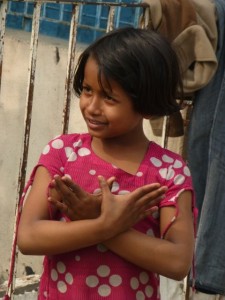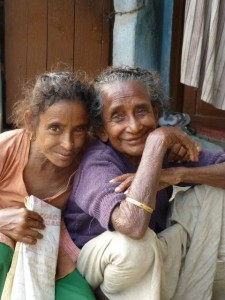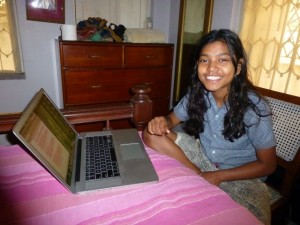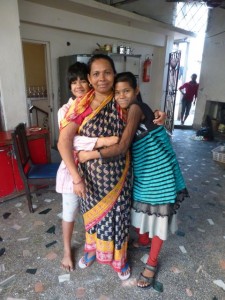Sangita Dey was driven from her village home by profound poverty. Actually, that’s not strictly accurate. Profound poverty didn’t drive her from her home. It drove her to believe a man who came to her village, promising he would take care of her and her children if she followed him to Calcutta. Being beaten and sexually molested byyour husband’s family will leave you vulnerable to such talk. With her two baby daughters, Sangita followed him. And indeed he took them to Calcutta. To a red light district.
Why not flee to her own family? Because her mother, a sex worker, had already died of AIDS. She never knew her father, only his name.
 Sangita went into a life of women working the street. She made nearly $6 that first night, more than she’d ever had in her life. Nearby she rented a room, where she lived with her two little girls. Every evening when she brought clients there she would put the two girls outside and tell the older one “Hold on to your sister and don’t let anyone take her.” Each time she emerged from her room she would find Juma crouched nearby, her arms wrapped tightly around the baby, hugging her to her chest. Turning three to four tricks per night at three dollars each, and paying only a few cents for rent, Sangita and her girls were no longer hungry. They went along like this for several years. But Juma was growing up wild. By age five she was unmanageable, and her sister Jasmin was following her lead. Sangita feared for them. And also, perhaps, felt burdened by them. When a friend introduced her to Urmi Basu, the founder of New Light, an NGO pursuing gender equality in India and providing full shelter for sex workers’ children, Sangita asked them to take her two girls.
Sangita went into a life of women working the street. She made nearly $6 that first night, more than she’d ever had in her life. Nearby she rented a room, where she lived with her two little girls. Every evening when she brought clients there she would put the two girls outside and tell the older one “Hold on to your sister and don’t let anyone take her.” Each time she emerged from her room she would find Juma crouched nearby, her arms wrapped tightly around the baby, hugging her to her chest. Turning three to four tricks per night at three dollars each, and paying only a few cents for rent, Sangita and her girls were no longer hungry. They went along like this for several years. But Juma was growing up wild. By age five she was unmanageable, and her sister Jasmin was following her lead. Sangita feared for them. And also, perhaps, felt burdened by them. When a friend introduced her to Urmi Basu, the founder of New Light, an NGO pursuing gender equality in India and providing full shelter for sex workers’ children, Sangita asked them to take her two girls.
That was nearly seven years ago. Things have turned out well for Sangita, who sat with me for an hour sharing her story. And of course I know her girls. I live in the same house as Juma, who’s now a bright, but naughty 11 year-old, going to school and staging dance competitions with her friends at Soma Home, the group home runby New Light. And Jasmine likes to play Angry Birds on my iPad, when I’m at the New Light crèche and shelter where she lives full time, in a different neighborhood from her sister. As for Sangita, she’s married and working as an office lackey. She visits her daughters often. But she has not taken them home. For these few weeks that I’m in Calcutta, I’m in the midst of such stories. I’m living with the 34 girls who are sheltered and supported at Soma Home, New Light’s housefor girls ranging from 9-18. Nearly all are daughters of sex workers. Some have mothers who have already died, perhaps from AIDS, perhaps alcohol. Some have mothers who saw men eying their daughter when she was only 7 and feared for hersafety. Some are daughters of women who have left the sex trade, thanks to micro-credit from New Light, and the desire not to shame a daughter who was now so well educated. Some have mothers who do not want to care for daughters, but who dote on the sons they keep at home.
 We eat together, make up word games with Bananagrams, share stories. Sometimes I help with lessons. On weekends, I’m allowed to take the young girls to a park to play. With the older girls I go to a Bollywood movie, for an evening of wild entertainment, accompanied by whistles and clapping when the audience approves, fortified by chips and Pepsi. Tomorrow some girls will teach me to cook a favored Bengali chicken recipe and I will teach them how to make ratatouille. When I told one of them the name of the dish she said, “Oh, if I tried to say that my teeth wouldfall out!”
We eat together, make up word games with Bananagrams, share stories. Sometimes I help with lessons. On weekends, I’m allowed to take the young girls to a park to play. With the older girls I go to a Bollywood movie, for an evening of wild entertainment, accompanied by whistles and clapping when the audience approves, fortified by chips and Pepsi. Tomorrow some girls will teach me to cook a favored Bengali chicken recipe and I will teach them how to make ratatouille. When I told one of them the name of the dish she said, “Oh, if I tried to say that my teeth wouldfall out!”
During the day I also go to the New Light crèche, which houses about 35 young children of sex workers and offers a haven to another 100 who come for a snack, a rest or a clean, safe place to play or get help with their studies. It’s in Kalighat, which is an old neighborhood, full of low, crumbling buildings, narrow lanes hung with drying sheets and saris, broader streets loud with hawkers, blaring music and honking horns.
To have credibility with the women it seeks to serve, New Light is in the midst of the red light area. Several sex workers at a time stand or squat at the entrance to the narrow, fetid lane where the shelter is housed in the ruins of an abandoned temple. They’re identifiable by the fact that a) they’re standing still while everyone else ismoving, and b) their bright saris and lipstick are unseemly for late afternoon. To reach New Light, I walk down the damp pavement, past women sitting on curbstones, alongside windowless rooms the width of one narrow bed, around mangy dogs nosing garbage, side stepping a man bucket-bathing against the wall. A fat woman pushes one enormous breast back under her sari. In a narrow courtyard, chickens scratch under the rope bed where a body lies curled in a red blanket,nothing visible but a head of tousled grey hair. A few people cluster together, talking loudly. I hurry my step, not sure if this is standard Bengali talk or a prelude to a fight.
I try not to breathe the cool reek that wafts from an open drain carrying murky black sludge, as it clashes with the warm stench flowing off the canal at the alley’s far end. Through a communal 8×8 courtyard, up a narrow, tiled stairway and I’m on the roof terrace which houses the New Light crèche and offices. For the children of Kalighat, it’s  a haven of laughter and lessons, of regular meals, naptimes, friendship and hugs. It’s clean, it’s predictable, it’s discipline, in other words everything that the teeming Kalighat alleys below are not. Without fail I am greeted by a child who hugs my waist hard, or tugs me by the arm calling, “Aunty, come see!” If I dare sit, my lap quickly holds a child ready to type on my iPad keyboard. And where there’s one, soon there will be five. But before that, I always stop at the top of the stairs to greet a wizened slip of a woman with a deformed hand. She lives in the 6×8 room at the top of the stairs, with her ancient mother and her alcoholic husband. Yesterday I saw her right eye was bloodied red. When I arrive she’s slowly, carefully pulling a broad toothed comb through her mother’s steel grey wisps of hair. Seeing me, she wraps her arms around her mother and points her chin in disgust at her husband. He’s asleepcrossed-legged, leaning against the wall, one arm flung out toward a filthy plastic water bottle filled with an amber liquid. We squat together for a few minutes and she stares deep into my eyes, her toothless mouth working in outrage and pain. She strokes her mother’s cheeks, then brings her twisted hand to her own and winces.
a haven of laughter and lessons, of regular meals, naptimes, friendship and hugs. It’s clean, it’s predictable, it’s discipline, in other words everything that the teeming Kalighat alleys below are not. Without fail I am greeted by a child who hugs my waist hard, or tugs me by the arm calling, “Aunty, come see!” If I dare sit, my lap quickly holds a child ready to type on my iPad keyboard. And where there’s one, soon there will be five. But before that, I always stop at the top of the stairs to greet a wizened slip of a woman with a deformed hand. She lives in the 6×8 room at the top of the stairs, with her ancient mother and her alcoholic husband. Yesterday I saw her right eye was bloodied red. When I arrive she’s slowly, carefully pulling a broad toothed comb through her mother’s steel grey wisps of hair. Seeing me, she wraps her arms around her mother and points her chin in disgust at her husband. He’s asleepcrossed-legged, leaning against the wall, one arm flung out toward a filthy plastic water bottle filled with an amber liquid. We squat together for a few minutes and she stares deep into my eyes, her toothless mouth working in outrage and pain. She strokes her mother’s cheeks, then brings her twisted hand to her own and winces.
By contrast, Soma Home is in a nice, lower middle class neighborhood. It’s quiet here, residential. There are towering mangos, palms, shrubs. The streets are wide and deserted. It’s quiet enough in the early morning that I can hear pigeons cooing. A heavy padlock secures the entrance gate, mainly to keep unwanted visitors out, though also to ensure the girls stay in. If you knew nothing about the girls’ history, their intelligence, exuberance and talent would persuade you you’d stepped into a girl’s camp. A somewhat crowded, noisy camp, with thread-bare sheets on the bed, girls sharing clothes, barrettes, shoes, not having any personal belongings to speak of, and never receiving letters from family, but otherwise just the same. There’s the teenage group that trains 3x/wk with Razia, national women’s boxing coach, judge and referee. There are the middle girls, into crafts  and making cards and bracelets for each other. There are the younger girls, who stage their own version of Dancing with the Stars. School is de rigueur, meals are nutritious, discipline is clear. Everyone takes a turn helping the cook prepare food. TV is allowed only on weekend evenings.
and making cards and bracelets for each other. There are the younger girls, who stage their own version of Dancing with the Stars. School is de rigueur, meals are nutritious, discipline is clear. Everyone takes a turn helping the cook prepare food. TV is allowed only on weekend evenings.
The girls at Soma Home are a joy to be with. The pure happiness in their eyes when a mother comes to visit (each Mom is allowed to come once a month) is a sight to behold. The mothers are so proud of their daughters. And the daughters clearly are devoted to their moms. Everyone has a story that would break your heart, and by rights should have broken theirs. But they’re strong! They’re optimistic! They have dreams! They love movie stars!! And nail polish!! Speaking of which, one mother I interviewed, who’s been a sex worker for 15 years, had a collection of 42 shades. Icouldn’t resist! Once we were done talking, we did our nails. Girls will be girls, don’t you know?!
Have I conveyed at all that this is a special place?
Note: The story of Sangita is a composite. Though I made up a name for her, the story itself is neither better nor worse than any history I’ve been told.

